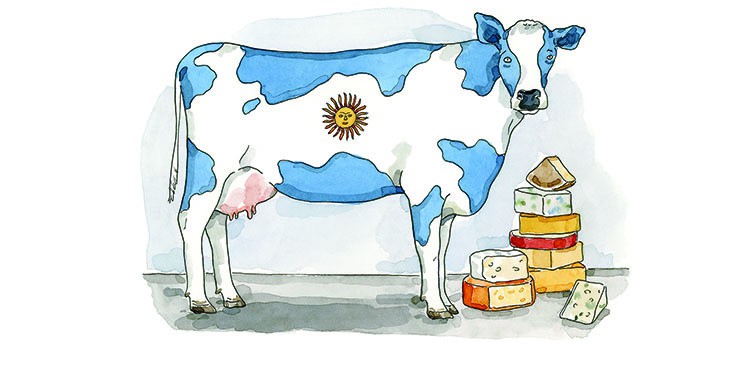
When I moved to Buenos Aires 10 years ago to study abroad, I was on a 13-year meat-free eating streak. I had heard that leading a vegetarian lifestyle in such a carnivorous country could be difficult, but I was determined to stick to my diet (and still find delicious sustenance). I did it—with the help of queso.
If you don’t know much about Argentine food, here’s a quick breakdown: Meat is king, cheese is queen, and bread and potatoes are successive royalty. I learned this on my first day in the country when I told a waiter I was vegetarian. I asked for a meat-free sandwich and salad; he brought me ham and cheese on toast with a side of potatoes and mayo. This scenario repeated itself several times before I wised up and mastered my no beef, no pork, no chicken ordering skills. Then I made cheese the center of my meals.
In Buenos Aires, wedges and wheels were all around me. At breakfast, my cortado (espresso with milk) came with either a tostado, a toasted sandwich oozing cheese, or a medialuna con queso, a croissant-like pastry stuffed with curds and warmed in the oven until gooey. For lunch, I’d go to the bakery for caprese miga, a tea sandwich with thin layers of mozzarella, tomato, and basil. Or I’d head to an empanada shop and order a cast of lactose-laden vegetarian flavors: empanada de queso y cebolla stuffed with queso de barra—a pasta filata–style cheese—and onion; empanada de verdura filled with béchamel sauce and Swiss chard; blue cheese empanada de Roquefort; and empanada de humita with creamy fresh corn and chèvre.
I also frequented porteño pizzerias and became well-versed in Argentine-style (read: cheese-loaded) pies. In fact, most locals judge slices by the quantity of queso used. Hanging around the standing room–only old-school pizza joints, I bumped elbows with regulars who filled up on fugazetta, the thick, high-rising dough topped with an obscene amount of mozzarella and onions, or napolitana con fainá, a slice with tomatoes, chopped garlic, and a thick coat of mozz, topped with a chickpea cake.
Parrillas (steakhouses) and asados (barbecues), two of Argentina’s favorite social pastimes, were more challenging to crack. While offering seemingly every cow part imaginable, the grills don’t carry many meat-free options—except for provoleta. An asado staple, provoleta is a semi-firm wheel that’s slapped on the barbecue and grilled until the outside forms a slightly burnt crust and the inside oozes melted goodness. It’s topped off with a dusting of dried oregano and a drizzle of olive oil. In recent years, vegetables have crept onto the grill, too. One common iteration: a halved red pepper stuffed with blue cheese and an egg.
After all this queso consumption, you might think I’d skip cheesy sweets…nope! Vigilante, also known as queso y dulce, is a traditional Argentine dessert consisting of cheese paired with dulce de batata (sweet potato paste) or dulce de membrillo (quince paste). Chocotorta, chocolate cookies layered with a mixture of dulce de leche and cream cheese, is a common no-bake birthday cake. And, of course, there’s the famous helado, creamy gelato that’s ubiquitous on sunny Buenos Aires days. Once I discovered the mascarpone-dulce de leche flavor—and that most heladerías deliver by the kilo, free of charge—there was no turning back.
When my semester abroad ended, I made two drastic life changes. First, I wasn’t ready to leave Buenos Aires—there was so much more to discover (and eat)—so I stayed. Second, I was ready to ditch the vegetarian lifestyle and taste what this beef-centric South American country was really about. From that day forward—after my first bite of chorizo sandwich—I was taken with Argentina’s carnivorous soul. And even though I finally found the beef, I never stopped devouring queso.




